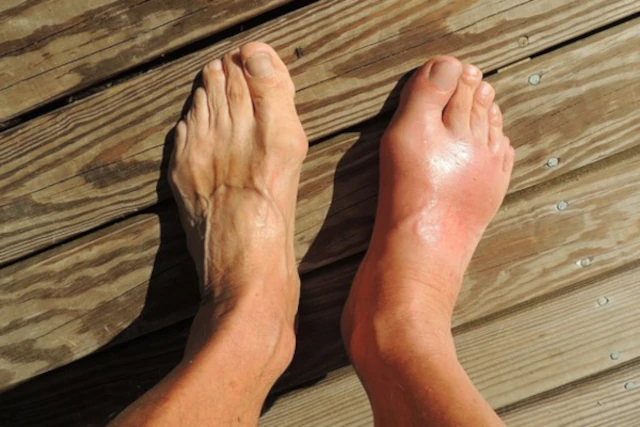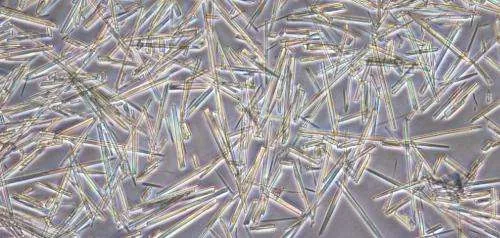Nierensteine, Gicht und Hyperurikämie

Demoskopische Analysen aus Deutschland (D) und England (UK) zeigen, dass das Praxis-Management einer klinisch relevanten Hyperurikämie häufig suboptimal ist. Zwar erhalten insgesamt 63 Prozent der betroffenen Patienten eine Therapie (93 % (D) und 89 % (UK) davon Allopurinol), aber nur bei 9-14 Prozent dieser Patientengruppe wird in 3,5- bis 5-jährigen Follow-up-Perioden eine Zielwert-Kontrolle durchgeführt [1] – obwohl Daten aus den USA zeigen, dass weniger als die Hälfte betroffener Patienten unter einer harnsäuresenkenden Therapie (ULT) die Zielvorgaben erreicht [2].
Fruktose erhöht Harnsäure-Spiegel
Historisch gesehen ist in den letzten 100 Jahren in der Bevölkerung ein progressiver Anstieg der Harnsäure-Serumspiegel zu beobachten, insbesondere bei westlicher Ernährung. Eine Ursache ist wahrscheinlich der erhöhte Konsum von fruktosehaltigen Zuckern. Ein Produkt, das wegen seiner hohen Süßkraft immer häufiger in industriell hergestellten Lebensmitteln verwendet wird. Der Fruktosestoffwechsel findet in der Leber statt, benötigt viel ATP (Adenosintriphosphat) und verbraucht intrazelluläres Phosphat.

Mikroskopische Aufnahme von nadelförmigen Harnsäure-Kristallen.
Quelle:
TU München.
Eine Meta-Analyse aus dem Jahr 2018 fand sieben Lebensmittel (Bier, Wein, Schnaps, Softdrinks, Geflügel, Kartoffeln) und Fleisch (z. B. Rind, Schwein, Lamm), die mit einem hohen Harnsäure-Serumspiegel assoziiert waren. Weitere acht Lebensmittel (z. B. Eier, Magermilch, Schwarzbrot, Nicht-Zitrusfrüchte, Käse, Getreide usw.) wurden in der Studie identifiziert, die mit einem reduzierten Harnsäure-Serumspiegel, aber mit einem hohen Proteingehalt assoziiert waren. Einige Studien bestätigen, dass Gemüse mit hohem Puringehalt nicht unbedingt mit Hyperurikämie oder Gicht assoziiert sind, aber bei Patienten mit fortgeschrittener Nierenschwäche oder Gicht vermieden werden sollte [12].
Pathogenetisches Potential von Harnsäure
Mehrere Mechanismen werden für den Zusammenhang zwischen Nierenschädigung und Hyperurikämie verantwortlich gemacht. Der am weitesten verbreitete Mechanismus ist die kristalline Ablagerung von Mononatriumurat (MSU) in Gelenken, Nieren und anderen Geweben. Studien haben gezeigt, dass das Serum ab einem Wert von über 6,5 mg/dl mit MSU übersättigt ist. Andere pathogene Mechanismen, die Harnsäure mit Nierenerkrankungen in Verbindung bringen, sind intrazelluläre prooxidative Eigenschaften, induzierte endotheliale Dysfunktion, Nierenfibrose und Glomerulosklerose.
Neuere Studien deuten darauf hin, dass Harnsäure die Transkription von Wachstumsfaktoren (NF-kB) und verschiedener vasoaktiver Substanzen wie Endothelin, Angiotensin II oder Thromboxan stimuliert. Darüber hinaus wird Harnsäure mit einer verminderten Synthese von Stickstoffmonoxid (NO) in Verbindung gebracht, das die Proliferation und Migration von Endothelzellen hemmt. All diese Effekte zusammengenommen führen zu einer starken Korrelation zwischen hohen Harnsäure-Konzentrationen und arterieller Steifigkeit bei Niereninsuffizienz. Über das Renin-Angiotensin-Aldosteron-System (RAAS) stimuliert Harnsäure die Xanthinoxidase, die NADPH-Oxidase und die Proliferation glatter Muskelzellen. Nierenfibrose in Form von tubulointerstitieller Fibrose und Glomerulosklerose wurde in einer klinischen Studie an 1700 Patienten mit bioptisch bestätigter Hyperurikämie nachgewiesen. Als Pathomechanismen werden die Aktivierung der epithelialen und endothelialen mesenchymalen Transition (EMT, EndoMT) diskutiert, die zur Aktivierung von Fibroblasten und Myofibroblasten und damit zur Nierenfibrose führen [12].
Harnsäure-senkende Therapie (ULT)
Xanthinoxidase(XO)-Hemmer sind die erste Wahl (First-Line-Therapie) bei der Behandlung von Hyperurikämie. Allopurinol ist ein purinähnlicher XO-Hemmer, Febuxostat und Topirostat sind nicht-purine XO-Hemmer. Im November 2017 hat die US-amerikanische Gesundheitsbehörde FDA eine Warnung vor der Verwendung von Febuxostat herausgegeben, da es möglicherweise mit einem erhöhten kardiovaskulären Mortalitätsrisiko verbunden ist und daher mit Vorsicht angewendet werden muss.
Die Second-Line-Therapie wird mit Probenecid und Benzpromaron durchgeführt. Kürzlich wurde gezeigt, dass die Einnahme von Benzpromaron bei Patienten mit Gicht mit einem geringeren Schlaganfallrisiko verbunden sein kann. Dennoch wurde Benzpromaron vom Markt genommen, weil es mit schwerer Hepatotoxizität in Verbindung gebracht wurde.
Bei der Therapie der Hyperurikämie wurde eine neue Generation von Urikosurika in Betracht gezogen, wie Lesinurad (2015 von der US Food and Drug Administration zugelassen), Arhalofenat und Dotinurad (2018 in Japan entwickelt). Darüber hinaus wird eine neue Generation von XO-Hemmern (3,4-Dihydroxy-5-nitrobenzaldehyd (DHNB)) untersucht, die ähnliche Eigenschaften wie Allopurinol haben, aber weniger toxisch sind und eine direkte antioxidative Kapazität aufweisen, die freie Radikale und die ROS-Produktion reduziert.
SGLT2-Inhibitoren, eine Behandlungsform zur Diabeteskontrolle durch Hemmung der Rückresorption von Glukose, Natrium und Harnsäure im proximalen Nieren-Tubulus, stellen eine vielversprechende Medikamentenklasse zur Senkung der Harnsäure dar. Sie sind insbesondere bei Diabetikern und Patienten mit chronischem Nierenversagen indiziert. SGLT2-Hemmer scheinen mit einer besseren Kontrolle der Harnsäure, einer Verbesserung des kardiovaskulären Risikos und einer Verlangsamung des Fortschreitens der Nierenerkrankung assoziiert zu sein. Derzeit gibt es drei orale SGLT2-Inhibitoren, die von der U.S. Food and Drug Administration und der European Medicines Agency zugelassen sind und für Patienten mit Typ 2 Diabetes mellitus und CKD mit einer eGFR > 30 mL/min/1,72 m2 empfohlen werden. Studien zeigten eine signifikante Verbesserung der Angiotensin-Hochregulation, eine Reduktion von Harnsäure, oxidativem Stress, arterieller Steifigkeit, Entzündung und Körpergewicht. Weitere potenzielle Vorteile von SGLT2-Inhibitoren könnten in der Reduktion von antiinflammatorischen, antioxidativen und antifibrotischen Markern liegen. Darüber hinaus wurden in Studien mit Ipragliflozin, Dapagliflozin und Empagliflozin reduzierte Spiegel von oxidativem Stress und Makrophagenmarkern (MCP-1, NF-kB, 8-OhdG, L-Fettsäure, Interleukin-6, Monocyte Attracting Protein-1) beobachtet. Bei den unerwünschten Wirkungen wurden am häufigsten Genitalinfektionen, Harnwegsinfektionen, Frakturen und diabetische Ketoazidose beobachtet [12].
Da alle harnsäuresenkende Medikamente gewissen Riskiken und Nebenwirkungen aufweisen, ist die Verordnung sorgfältig zu prüfen. Eine Indikation zur Einleitung einer harnsäuresenkenden medikamentösen Therapie liegt dann vor, wenn mindestens ein gesicherter Gichtanfall aufgetreten ist, bei Tophi, Nierensteinen, Urat-Arthropathien und wenn generell Urat-Kristalle diagnostiziert werden [3]. Bislang galt die Empfehlung, mit der ULT erst nach dem vollständigen Abklingen eines akuten Gichtanfalls zu beginnen. Im Gegensatz zur gängigen Praxis konnte eine kontrollierte Studie zeigen, dass der Beginn aber auch während eines akuten Anfalles möglich ist [4].
Nephro- vs. Neuroprotektion
Hohe Serum-Harnsäure-Konzentrationen (≥ 6.8 mg/dl (408 µmol/l)) erhöhen das Risiko für chronisches Nierenversagen (CKD) [5]. Dennoch ist eine exzessive medikamentöse Senkung zu vermeiden, da Harnsäure mit der Intelligenz korreliert [6], ein neuroprotektiver Faktor für Dopamin-Neuronen ist und das Risiko für Morbus Parkinson [7] u.a. neurodegenerative Erkrankungen senken kann [3]. Im Praxis-Management der ULT ist daher ein regelmäßiges Follow-up mit Zielwert-Kontrolle unerlässlich, um die nicht immer einfache Gratwanderung, Nephroprotektion auf der einen Seite und Neuroprotektion auf der anderen, zu bewältigen.
Darüber hinaus ist unklar, ob die Gabe von Allopurinol die Nieren schützen kann. So dokumentiert eine Metaanalyse [8], eine „substantielle Heterogenität“ bezüglich einer nephroprotektiven Wirkung von Allopurinol: Fünf Studien zeigten keinen Effekt auf die glomeruläre Filtrationsrate (GFR), während bei drei klinischen Studien die Zunahme der Kreatinin-Konzentrationen verlangsamt werden konnte.
Harnsäure-senkende Medikamente kritisch betrachten
Die Hinweise, dass bestimmten Subpopulationen unter einer medikamentösen Harnsäure-senkenden Therapie (ULT) geschadet wird, führte zu der Empfehlung, eine asymptomatische Hyperurikämie – auch bei begleitender Nierenschwäche – zunächst nicht mit harnsäuresenkenden Medikamenten zu behandeln. Zur Sicherheit sollte bei diesen Patienten alle sechs Monate Kreatinin als Nierenfunktionswert kontrolliert werden. Treten allerdings Urat-Kristalle im Urin-Sediment auf oder werden auffällige Alterationen im muskulo-skelettalen Ultraschall beobachtet, ändert sich die therapeutische Situation und eine ULT sollte rasch eingeleitet werden, um u.a. Nierenschäden zu vermeiden [6].
Bikarbonat schließt therapeutische Lücke
Aus praktischer Sicht liegt mit magensaftresistentem [9] Natriumbikarbonat eine medikamentöse Option vor, die diese therapeutische Lücke schließen kann. Neben einer sicheren Nephroprotektion [10] wirkt Natriumbikarbonat direkt auf die Urat-Kristall-Bildung [11] und könnte als vorgeschobene Monotherapie eine ULT vermeiden oder hinauszögern. Durch eine Urin-Alkalisierung auf pH 8 können bereits vorhandene Urat-Kristalle aufgelöst und eine weitere Bildung in den Nierentubuli gehemmt werden. Eine Urin-Alkalisierung wird mit 325-2.000 mg Natriumbikarbonat per os, 1-4x/d, erreicht [6].
Fazit: Harnsäuresenkende Medikamente sollten für Hoch-Risiko-Patienten reserviert bleiben. Ein unkritischer und unkontrollierter Einsatz könnte neuroprotektive Faktoren reduzieren und entfernt die Harnsäure-Messung als Marker für eine chronische Niereninsuffizienz aus dem diagnostischen Repertoire. Um bei Hyperurikämie Urat-Kristall-Ausfällungen und Nierenschäden zu vermeiden, ist sowohl eine Monotherapie wie auch eine zur ULT adjuvante Urin-Alkalisierung mit oralem Natriumbikarbonat therapeutisch sinnvoll.